|
|
 |
|
December 31, 2009
The first purchase I made on credit was a receiver, turntable and speakers from a Pacific Stereo store in Southern California. The price was only $199, yet I was in college and unable to pay cash. Pacific Stereo financed my purchase, and while the interest was crazy in relation to the cost of the system, it was worth every cent, as it blasted Linda Ronstadt, the Eagles, David Bowie and Fleetwood Mac in my apartment, as well as the unfortunates who lived above and below me.
The wines of Navarro Vineyards, from Mendocino County's chilly Anderson Valley, are also worth every penny -- refreshingly dry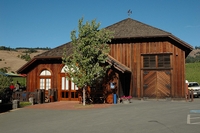 Rieslings, Gewurztraminers and Muscats, a la Alsace; crisp, nuanced Chardonnays and Pinot Noirs, and late-harvest wines that are sublimely rich yet nervy in their acidity. Their prices are remarkably low compared to their outstanding quality -- $19 for Riesling, Gewurztraminer and Muscat; $19 for the Mendocino County Pinot Noir and $29 for the Methode a l'Ancienne Anderson Valley Pinot Noir; $16 for a pretty blended rosé, and $29 for the outrageously rich and racy Cluster Select Late Harvest Riesling, as good as Napa Valley’s Dolce ($85) and Beringer Nightingale ($40) dessert wines, and less expensive. Rieslings, Gewurztraminers and Muscats, a la Alsace; crisp, nuanced Chardonnays and Pinot Noirs, and late-harvest wines that are sublimely rich yet nervy in their acidity. Their prices are remarkably low compared to their outstanding quality -- $19 for Riesling, Gewurztraminer and Muscat; $19 for the Mendocino County Pinot Noir and $29 for the Methode a l'Ancienne Anderson Valley Pinot Noir; $16 for a pretty blended rosé, and $29 for the outrageously rich and racy Cluster Select Late Harvest Riesling, as good as Napa Valley’s Dolce ($85) and Beringer Nightingale ($40) dessert wines, and less expensive.
And did I mention that Ted Bennett, a founder of Pacific Stereo, and his wife, Deborah Cahn, own Navarro Vineyards? It's a nice little coincidence, as I fell in love with their wines long before I learned that, by extension, it was Ted who made it possible for me to have a sound system when I really couldn’t afford one. Thank you, sir.
Navarro's wines, made by long-time winemaker Jim Klein, show precise varietal character, plenty of natural acidity, moderate alcohol levels and superb balance. You won’t find them in stores, although they're on numerous restaurant lists, particularly those featuring Thai, Vietnamese, Chinese, Indian and other spice-driven dishes, for which Navarro’s Alsace-style white wines are very complementary. Also buy the wines at Navarro’s friendly, unpretentious Philo tasting room, or order them direct from the winery. Get on the mailing list, and receive discounts, pre-release shipments, and what just might be the best winery newsletter in the business.
It took a trip to New York's Finger Lakes region for me to discover 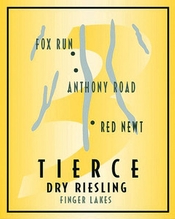 Tierce Dry Riesling Seneca Lake ($24), a collaboration of the petrol and wet slate on the nose, and the palate is startlingly brisk, with grapefruit, lime, candied lime peel and red currant notes. Very dry and bracing, with wonderful balance, it should age beautifully for a decade or more, yet it’s also delicious now, for those (like me) who adore assertive, high-acid wines. The Finger Lakes' cold climate doesn't agree with me, yet its wines certainly do, particularly its Rieslings. I wish more of them found their way to the West Coast. Tierce Dry Riesling Seneca Lake ($24), a collaboration of the petrol and wet slate on the nose, and the palate is startlingly brisk, with grapefruit, lime, candied lime peel and red currant notes. Very dry and bracing, with wonderful balance, it should age beautifully for a decade or more, yet it’s also delicious now, for those (like me) who adore assertive, high-acid wines. The Finger Lakes' cold climate doesn't agree with me, yet its wines certainly do, particularly its Rieslings. I wish more of them found their way to the West Coast.
Close second: The Chateau Ste. Michelle & Dr. Loosen 2008 Eroica Riesling ($20) from the Columbia Valley in Washington State. It's slightly sweeter than the Tierce, with 1.77 percent residual sugar, yet it's still vibrant and mouthwatering. It's the best Eroica yet; could Wendy Stuckey, former Riesling maker at Wolf Blass in Australia and now the white winemaker at Chateau Ste. Michelle, have added an extra note or two to Eroica?
Posted by Linda Murphy at 5:19 PM
|
|
December 30, 2009
Winery of the Year- The Eyrie Vineyard
Many reasons exist for choosing a winery as your Best of the Year. I have named The Eyrie Vineyard as my Best Winery of the Year for reasons that include long term performance, historical significance and personal fondness for the people and the wines -- and also as an opportunity to memoralize David Lett, the winery’s inimitable founder and winemaker, who passed away this year. reasons that include long term performance, historical significance and personal fondness for the people and the wines -- and also as an opportunity to memoralize David Lett, the winery’s inimitable founder and winemaker, who passed away this year.
2009 marks the 40th harvest for The Eyrie Vineyard, a fairly small family winery founded by David and Diana Lett in 1966 in Oregon’s Dundee Hills. In 1965, Lett planted the first Pinot Noir and Chardonnay in Oregon’s Willamette Valley and the first Pinot Gris in America. In 1979 and 1980, his 1975 Pinot Noir competed against Burgundies in international competition in Paris and Beaune, and turned the attention of the wine world for the first time toward Oregon. In the years since, the winery has grown and produced several dozens of world-class Pinot Noirs and Chardonnays, as well as excellent Pinot Gris and Pinot Blanc wines. To many critics, the refined, elegant, finessed Pinot Noirs of The Eyrie Vineyard represent the epitome of the grape’s potential; its white wines are complex, restrained and equally fine. The winery’s philosophy is to intervene as little as possible in the vineyard (the vines are ungrafted, for example, and are not treated with herbicides, fungicides or insecticides) and also in the winemaking (minimal racking, extended lees contact, no fining and minimal filtration). The wines are an expression of the vineyards and the family’s philosophy, and as such are quite unique and very special.
Jason Lett assumed his father’s responsibilities as vineyard manager and winemaker in 2005. His wines spring from the same inspiration as his father’s. Besides being a milestone vintage, 2009 marked an important passage for The Eyrie Vineyards, both a continuation and a new beginning.
Wine of the Year -- 2007 Taylor Fladgate Porto
This is a monumental wine from a great vintage and an outstanding 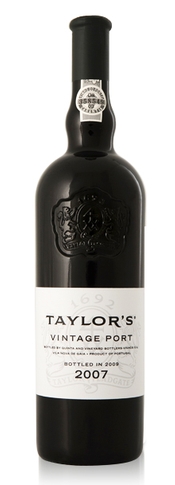 producer. Thanks to the even ripening of the grapes during a growing season without excessive heat, the wine has deep, intense fruit character that’s very ripe but also fresh. Aromas of dark berries, red berries, toasted hazelnuts and spice spill from the glass; in the mouth, the flavor is rich but the notes are currently less articulated than in the nose, even after the wine spent 24 hours in an open decanter. This wine has the strong tannin that a Vintage Port needs for long aging, but the tannins are remarkably soft and ripe, creating an admirable balance of fruit to tannin. This wine is actually approachable now because of its beautiful fruit component and the softness of its tannins but in time it should gain amazing complexity, and its latent power will emerge. You can cellar for it 30, 40, 50 or more years. producer. Thanks to the even ripening of the grapes during a growing season without excessive heat, the wine has deep, intense fruit character that’s very ripe but also fresh. Aromas of dark berries, red berries, toasted hazelnuts and spice spill from the glass; in the mouth, the flavor is rich but the notes are currently less articulated than in the nose, even after the wine spent 24 hours in an open decanter. This wine has the strong tannin that a Vintage Port needs for long aging, but the tannins are remarkably soft and ripe, creating an admirable balance of fruit to tannin. This wine is actually approachable now because of its beautiful fruit component and the softness of its tannins but in time it should gain amazing complexity, and its latent power will emerge. You can cellar for it 30, 40, 50 or more years.
Posted by Mary Ewing-Mulligan at 10:39 AM
|
|
December 29, 2009
[We'll be running our contributors' picks for the best wine performances for 2009 on a dialy basis through the end of the year, so stay tuned. Michael Franz]
Producer of the Year: Lopez de Heredia, Rioja, Spain
Walking into the cellars at Lopez de Heredia was one of my most memorable experiences in the wine world. The glass tasting building 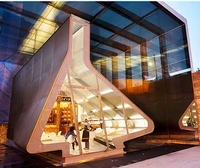 has a cool decanter-shaped design by architect Zaha Hadid, so what's awaiting you underground is a shock. has a cool decanter-shaped design by architect Zaha Hadid, so what's awaiting you underground is a shock.
Black mold and cobwebs, everywhere. You feel like you've stepped back in time, maybe to the Spanish Inquisition.
"Many wineries don't really use the cellar so they clean off the walls," says winemaker Mercedes Lopez de Heredia. "They don't want the mold. This is how a natural cellar really looks."
"Of the year" awards tend to go to new kids on the block -- people making innovations that have changed the market or industry.
But this year, tradition is the new black. Wine geeks aren't into pushing science forward anymore. Everybody's excited about open-air fermentation, cement tanks, native yeasts -- the way wine was made by our grandparents.
You could probably get more traditional than Lopez de Heredia. But this winery is so into age, it's freaky. The current release of their Vina  Tondonia red wine, their flagship brand, is 1991. For the Vina Tondonia white, it's 1987. Even their bottom-of-the line Cubilla wine, a Crianza, has a 2001 current release. Tondonia red wine, their flagship brand, is 1991. For the Vina Tondonia white, it's 1987. Even their bottom-of-the line Cubilla wine, a Crianza, has a 2001 current release.
"We are famous for not accelerating the making of a wine," Lopez de Heredia says.
And not just with wines -- they have some oak barrels that are 80 years old. Rather than buy new barrels, they prefer to replace individual broken staves on the old ones. For this, they have an on-site carpentry staff, which they keep busy by also making all their own doors.
"It costs more to repair barrels than to make new ones," Lopez de Heredia says. "But it is better for the wines. We want the micro oxygenation of the wine to be as slow as possible. For us, oak is a way for the wine to get better but it must not taste of wood."
As for the cobwebs, she says, "The spiders are a natural way of taking care of fruit flies," which are a problem for the corks. This is an issue when you have whole racks of wines from 1890 sitting around in your cellar. But Lopez de Heredia says wines that are too old are a gamble, so she refuses to sell anything bottled before 1942.
Lopez de Heredia learned her excellent English as an exchange student in the US. She spent 12th grade in Kentucky.
"My father sent the family wine for Christmas," she said. "They were Baptists, they don't drink. They gave it away to some Catholic friends. I was 18. I couldn't believe I didn't have wine with Christmas. I drank a beer and they almost sent me back to Spain."
What I can't believe is that anyone would turn down the chance to try one of these wines, well-preserved by cobwebs and mold. I used flash to take a photo of one particularly ancient looking pile of bottles and noticed they were whites. Turned out they were from 1970, the year of Mercedes Lopez de Heredia's birth, and yes, they are for sale (if you ask). I asked to try one. To say she "dusted it off" doesn't really convey the amount of cleaning the bottle needed before it could be opened. But wow -- that was my most memorable wine of the year, from my most memorable winery visit of the year.
What's greatest about Lopez de Heredia is that your granddaughter might be able to go there, to that exact pile of wines, and buy a bottle, and it might be even better.
Wine of the Year: 1970 Viña Tondonia Rioja Blanco
The color is golden yellow, and despite its age and lack of filtering the wine is clear. Initially it smells of ripe pear, honey, dried apple and wildflowers. The floral complexity increases as it warms. On the palate, there's still plenty of acidity. I could write a lengthy paragraph about the flavors using just nouns. Here are a few: pear, dried apple, flowers, walnut bread, minerality, macadamia nuts, cashews, peanuts. It gets more and more nutty with air. The mouthfeel is mead-like, honeyed but completely dry. It's sensual and still very fresh. An amazing experience. I refused to leave the winery until we finished the last drop; the wine deserved our complete respect. 100 Points
Posted by W. Blake Gray at 3:07 PM
|
|
December 28, 2009
[We'll be running our contributors' picks for the best wine performances for 2009 on a dialy basis through the end of the year, so stay tuned. Michael Franz]
Producer of the Year -- Concha y Toro: This large Chilean company excels at all levels. From its bargain-priced Casillero del Diablo line to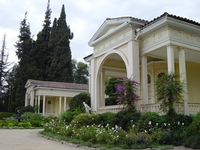 its top-level estate wines, including the iconic Don Melchor, it consistently over-delivers, offering more quality for less money than the vast majority of its commercial competitors. (Perhaps the best examples are the wines under the Marques de Casa Concha label. They sell for roughly $20, and taste like they should cost $40.) During economic hard times, what more can a wine-loving consumer ask for? its top-level estate wines, including the iconic Don Melchor, it consistently over-delivers, offering more quality for less money than the vast majority of its commercial competitors. (Perhaps the best examples are the wines under the Marques de Casa Concha label. They sell for roughly $20, and taste like they should cost $40.) During economic hard times, what more can a wine-loving consumer ask for?
Wine of the Year – American Pinot Gris: Looking back over 2009, I 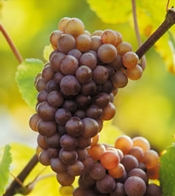 find that I was most impressed not by a single bottle but by a category -- American (primarily West Coast) Pinot Gris. Whether coming from California, Oregon, or Washington, these wines consistently offered vivid fruit flavors and a refreshing but full-fleshed profile. In my tastings they regularly outperformed other types of American white wines, notably better-selling but frequently unsatisfying Chardonnays and Sauvignon Blancs. I encountered a few disappointing examples, but on the whole the quality was remarkably high. Prices tend to reasonable, with few wines crossing the $20 threshold, and the combination of weight on the palate and bright acidity makes them wonderfully food-friendly. Few consumers as yet have gotten on the Pinot Gris bandwagon. I hope WRO readers will hop aboard. find that I was most impressed not by a single bottle but by a category -- American (primarily West Coast) Pinot Gris. Whether coming from California, Oregon, or Washington, these wines consistently offered vivid fruit flavors and a refreshing but full-fleshed profile. In my tastings they regularly outperformed other types of American white wines, notably better-selling but frequently unsatisfying Chardonnays and Sauvignon Blancs. I encountered a few disappointing examples, but on the whole the quality was remarkably high. Prices tend to reasonable, with few wines crossing the $20 threshold, and the combination of weight on the palate and bright acidity makes them wonderfully food-friendly. Few consumers as yet have gotten on the Pinot Gris bandwagon. I hope WRO readers will hop aboard.
Posted by Paul Lukacs at 3:49 PM
|
|
December 27, 2009
[We'll be running our contributors' picks for the best wine performances for 2009 on a dialy basis through the end of the year, so stay tuned. Michael Franz]
My selection for “Wine Producer of the Year” is Littorai Wines, located in Sonoma’s Russian River Valley. Its new winery is situated between Sebastopol and Freestone in western Sonoma, near the coast.
The winemaker-owner, Ted Lemon, had impressive credentials before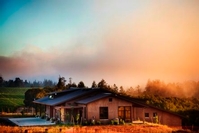 he opened Littorai in 1993. Lemon was the first American to become a winemaker in Burgundy! In fact I find his Pinot Noirs to be the closest in style to red Burgundy, although Ted doesn’t like the comparison. “I make California Pinot Noirs in the style I like to drink them,” asserts Lemon. he opened Littorai in 1993. Lemon was the first American to become a winemaker in Burgundy! In fact I find his Pinot Noirs to be the closest in style to red Burgundy, although Ted doesn’t like the comparison. “I make California Pinot Noirs in the style I like to drink them,” asserts Lemon.
I have tasted just about every major Pinot Noir in California during the past two years, while doing research for California Wine for Dummies. After first tasting a Littorai Pinot Noir in a New York restaurant, I made it my business to visit Littorai in the spring of this year. I was truly enchanted by Littorai’s 2007 Pinot Noirs: they are pure, vibrant, and lively, the kind of Pinot Noirs a Burgundian would make in California. They are NOT overripe, jammy, too high in alcohol, overly oaked, or heavy--the characteristics too many California Pinots share.
Littorai’s Pinot Noirs really sing, but most need two or three years to develop. Its 2005 Pinot Noirs were excellent, 2006s almost as good, and the 2007s might be Littorai’s best yet. Littorai is currently selling nine Pinot Noirs, most of which are single-vineyard 2007s. Littorai also has four superb Chardonnays available, but the Pinot Noirs are the stars. My personal favorites are the 2007 Littorai Hirsch Vineyard and 2007 Littorai Summa Vineyard, both located on the true Sonoma Coast.
You will not find Littorai in your local wine shop. You can buy the wines directly from the winery, online. If you prefer to try them first, check out the list of restaurants across the country that carry Littorai; the winery’s website provides that information for you.
Wine of the Year, 2009
My wine of the year is Champagne Henriot Blanc Souverain NV (average retail price, about $55). I put Henriot’s Blanc Souverain --soon to be re-named Blanc de Blancs --in a tie with Henriot’s magnificent 1996 Brut, which retails in the very reasonable $60 to $70 range.
For me, this is the year for Champagne Henriot. It has never been better. I love the style of this house; its Champagnes are very dry, vibrant, elegant, and complex. They are perfect apéritif Champagnes, especially the Blanc Souverain, which is the best Blanc de Blancs for the money available today, in my opinion. The Henriot 1996 Brut, on the other hand, reflects the power of this vintage. It has the amazing combination of the 1996 vintage: perfect ripeness combined with lively acidity. I would hold on to the 1996 Henriot for another five to seven years before drinking it; it really needs time to mature.
By the way, I had a preview tasting of Henriot’s soon-to-be released 1996 prestige cuvée, its Cuvée des Enhanteleurs. Oh, my goodness, what an explosive Champagne! It just bowled me over. If it were available this year, it would have been my wine of the year. It will be released in Spring, 2010. Look for it!
Posted by Ed McCarthy at 10:08 AM
|
|
December 22, 2009
The Concise World Atlas of Wine
By Hugh Johnson and Jancis Robinson
Paperback/352 pages/200 full-color maps
Mitchell/Beazley/An imprint of Octopus USA/pub date September 2009
$29.99
Since its first publication in 1971, Hugh Johnson and Jancis Robinson’s comprehensive World Atlas of Wine has been an invaluable source of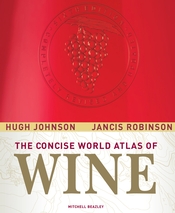 information for those of us who have a thirst for learning about wine as well as for drinking it. (Disclosure: I am a regular contributor to Mr. Johnson’s annual Pocket Wine Book, also published by Mitchell Beazley). Now in its sixth edition, the authors’ classic guide to the wine regions of the world has been joined by a companion book, the Concise World Atlas of Wine. This smaller, 352 page paperback version is meant to be a more portable version of the original tome, but weighing in at 3 pounds, and measuring 8 by 10 inches, it’s not going to fit easily in your purse let alone your back pocket. But never mind--throw it into the back seat of your car and head off to wine country with it. You’d be hard pressed to find another guide to wines from every corner of the globe that’s as reliable, well organized and engaging as this one. Written by two of the world’s most knowledgeable and erudite wine writers, the book is distinguished by succinct yet friendly prose. It also includes the same detailed, full-color maps that are in the original, although in the smaller format they’ll be useful mainly for wine buffs with either keen close-up vision or superior magnifying eyeglasses. information for those of us who have a thirst for learning about wine as well as for drinking it. (Disclosure: I am a regular contributor to Mr. Johnson’s annual Pocket Wine Book, also published by Mitchell Beazley). Now in its sixth edition, the authors’ classic guide to the wine regions of the world has been joined by a companion book, the Concise World Atlas of Wine. This smaller, 352 page paperback version is meant to be a more portable version of the original tome, but weighing in at 3 pounds, and measuring 8 by 10 inches, it’s not going to fit easily in your purse let alone your back pocket. But never mind--throw it into the back seat of your car and head off to wine country with it. You’d be hard pressed to find another guide to wines from every corner of the globe that’s as reliable, well organized and engaging as this one. Written by two of the world’s most knowledgeable and erudite wine writers, the book is distinguished by succinct yet friendly prose. It also includes the same detailed, full-color maps that are in the original, although in the smaller format they’ll be useful mainly for wine buffs with either keen close-up vision or superior magnifying eyeglasses.
One of the Concise Atlas’s principle strengths is that, unlike most wine guides, this one frequently offers a point of view in addition to simply stating the facts. Take the description of Loire Valley wines, which the authors describe as “light and invigorating, with palpable acidity. The classic word for them is charming; the classic mystery that they are not more widely appreciated outside northern France. These wines are casualties of the modern wine drinker’s obsession with weight and strength.”
Like fizz in wine, some passages in the atlas sparkle with a stylistic effervescence that makes the densely packed volume of serious information particularly palatable. Indeed, some of the prose is downright literary. Take the introduction to the section on Japan (yes, there is a wine is made there, in 36 of the country’s 43 prefectures): “In constructing Japan, nature seems to have had almost every form of pleasure and enterprise in view except wine,” the authors write. “Although the latitude of Honshju, the main island of the Japanese archipelago, coincides with that of the Mediterranean, its climate does not. Like the eastern USA (lying in the same latitudes), it suffers from having a vast continent to the west. Caught between Asia and the Pacific, the greatest land and sea masses in the world, its predictably extreme climate is peculiar to itself. Winds from Siberia freeze its winters; monsoons from the Pacific and the Sea of Japan drench its springs and summers. At the precise moments when the vines most need sunshine they are lashed by typhoons … It is not surprising, therefore, that Japan has hesitated about wine; hesitated, that is, for about 1,200 years.”
Extracted from the 2008 World Atlas, Concise lacks the photographs from the original tome, but it offers the same information about latitudes, altitudes, temperature variations, grape varieties, appellations, and all the other details pertinent to the world’s wine regions. There is the occasional glitch: for example, I followed instructions to turn to page 235 for information about North America’s French hybrid grapes, but discovered instead a page on the wines of North Africa. And speaking of hybrids, the eastern United States gets short shrift, with far too much precious space wasted on a rehashing of the region’s past history of wines made from hybrid and native grapes, and too little emphasis on today’s tremendous success with vinifera wines. But aside from these minor quibbles this is that rare wine reference book that is overall as well balanced and satisfying as a bottle of Echézeaux. And at $29.99 it’s a lot cheaper than fine Burgundy.
Posted by Marguerite Thomas at 5:39 PM
|
|
December 15, 2009
By Ed McCarthy and Mary Ewing-Mulligan ($17, Wiley Publishing)
My Wine Review Online colleagues Ed McCarthy and Mary Ewing-Mulligan have written another helpful book in their Wines for Dummies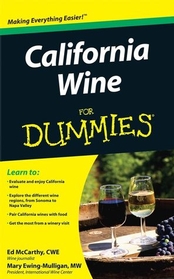 series. This one, on California wine, could be the most useful of them all for North American readers, since 70% of all wine consumed in the United States comes from California. If you’re already familiar with this duo’s engaging style, and with the Dummies’ user-friendly format, you know that you’re in for the literary equivalent of having two old friends take you by the hand and lead you safely through some complex terrain, pointing out useful signposts and interesting scenery along the way. Experienced wine consumers may find some of the data pretty basic, but the book is chock-full of titillating tidbits as well as substantial information from which we can all learn. Do you know, for example, the difference between “variety” and “varietal” (the answer is on page 27), or which was the best vintage from 1990 to 2000 (page 230)? Can you name eighteen consistently reliable California Merlots costing less than $15 (page 128), and can you guess what gets the authors’ vote as “the least known most important white wine grape variety in the world” (page 98)? series. This one, on California wine, could be the most useful of them all for North American readers, since 70% of all wine consumed in the United States comes from California. If you’re already familiar with this duo’s engaging style, and with the Dummies’ user-friendly format, you know that you’re in for the literary equivalent of having two old friends take you by the hand and lead you safely through some complex terrain, pointing out useful signposts and interesting scenery along the way. Experienced wine consumers may find some of the data pretty basic, but the book is chock-full of titillating tidbits as well as substantial information from which we can all learn. Do you know, for example, the difference between “variety” and “varietal” (the answer is on page 27), or which was the best vintage from 1990 to 2000 (page 230)? Can you name eighteen consistently reliable California Merlots costing less than $15 (page 128), and can you guess what gets the authors’ vote as “the least known most important white wine grape variety in the world” (page 98)?
The book offers tips on making a pilgrimage to California wine country, including which wineries are the most hospitable, which ones have great art collections, and everything you need to know about tours, tastings, and transportation. The authors steer the reader towards great places to dine in California wine country, and they offer succinct suggestions for lodging in the state’s most famous wine regions as well as in lesser- known wine districts such as the Anderson Valley (“The place to stay in the Anderson Valley is the Boonville Hotel in the town of Boonville. It dates back to the 19th century, and it offers a lot of charm along with good food.”).
It’s hard for even the most dedicated wine professional to keep up with the constantly evolving details surrounding California wine--the regulations, nuances, brands, prices, labels, climate variations and vineyard designations. Because McCarthy and Ewing-Mulligan know their subject so thoroughly they truly can help demystify it for the rest of us. They tell you everything you need to know about AVAs--American Viticultural Areas--as well as WHY you need to know. They de-code cult Cabs, zero in on Zin and share insights about Chardonnay. And while their writing style is simple, the authors never talk down to us, the readers. Yes, the book’s format is formulaic, but it’s never boring, and is sometimes even amusing. What other wine writers can you think of who compare wine to a cat? “Some of the very best wines we’ve enjoyed,” they write,” have been made from Pinot Noir. But like our largest male cat, Max (who is so lovable and yet drives us crazy most of the time), Pinot Noir wines often frustrate us.”
In the book’s introduction the authors write, “California today is truly a land of opportunity for wine lovers.” California Wine for Dummies will help any smart wine lover embrace that opportunity to the fullest.
Posted by Marguerite Thomas at 11:09 AM
|
|
December 9, 2009
"Learning how to taste wine is a bit like sex … while it’s all a bit awkward at first, the more you practice the better at it you’re likely to become." So writes Matt Skinner in his new book Heard It Through the Grapevine-Things You Should Know to Enjoy Wine. become." So writes Matt Skinner in his new book Heard It Through the Grapevine-Things You Should Know to Enjoy Wine.
Since I periodically receive books about wine and/or food to review, over the next couple of weeks I’m going to share a few of the titles that have recently caught my attention for one reason or another. This one, penned by a tousle-headed surfer dude from Down Under, strives to present wine in an amiable, engaging, informal yet informative way, and for the most part he succeeds. The book offers a huge amount of advice about all the gadgetry associated with wine--corkscrews, decanters, glassware and so on--but the real strength of Things You Should Know lies in its good natured guidance along the sometimes bewildering world of wine. While much of the content is geared to young adults who are relatively new to the particulars of wine, Skinner offers plenty of advice we might all benefit from. In the chapter Love What You Drink he writes: “I don’t just want you to know that you like what you’re drinking. That’s not enough. I want you to know what you like about it and why.” Maybe that sounds obvious, but those of us who still feel we have a lot to learn about wine (by which I mean everyone) could profit by being nudged into a more honest examination of what we’re tasting rather than experiencing a merely visceral reaction to it.
Skinner refers to wine’s basic characteristics as “tools.” For example, he writes that acidity helps cut through oily textures in food: “It is a naturally good tool for cleaning and refreshing your palate.” Tannin, which “is great at working to get through major obstacles such as protein and fat,” is another critical tool. “In the grand scheme of things, finding a wine with the right tools is just as important as finding a wine with the right flavors and texture,” he writes.
There are perhaps no big surprises in the food and wine pairing section of his book, but Skinner’s enthusiasm can rev up the reader’s own desire to rush out and put together even traditional partners such as Fino sherry and green olives. (“Fino and Manzanilla sherry are two of the greatest food-friendly wines produced anywhere in the world,” he reminds us). Duck and Pinot Noir, according to Skinner, “share an almost spiritual relationship,” while Sauvignon Blanc and goat cheese make “an incredible marriage. Two ingredients, one crisp and angular, the other pasty and chalklike, yet together they seem to disarm one another, smoothing out the hard edges as they go.”
You may not always appreciate Matt Skinner’s super-relaxed style, and some of the material he presents--“the difference between good years and bad years comes down to Mother Nature”--can be, well, elemental, but overall there is plenty to like about this basic guide to wine appreciation. It isn’t going to replace the tried and true tomes found on any true oenophile’s bookshelf, but it certainly would make a good gift, especially for a wine newbie who might be put off by some of the more straight-laced books of wine education, for this one is both hip and helpful. “Step outside your comfort zone and open your mind to trying new things,” advises Matt Skinner. This book just might be one of them.
Matt Skinner, 2009, published by Mitchell Beazley/Octopus Books USA, $24.99 hardcover
Posted by Marguerite Thomas at 11:22 AM
|
|
December 2, 2009
 I take a look at California sparkling wine in my Creators Syndicate column this week. The sinking dollar combined with the reluctance on the part of Champagne producers to lower prices to whittle inventory make alternative bubblies most attractive this holiday season. I take a look at California sparkling wine in my Creators Syndicate column this week. The sinking dollar combined with the reluctance on the part of Champagne producers to lower prices to whittle inventory make alternative bubblies most attractive this holiday season.
You could turn to Prosecco or Cava, but for my money the greatest bang for the buck is California sparkling wine, which is produced in the Champagne tradition, where the second fermentation -- the one that makes the bubbles -- occurs in the bottle.
California sparkling wine producers are few in number, but their attention to detail and commitment to quality are evident in the sophistication and pleasure delivered by their wines.
Here's a smippet from the column:
'Tis the season to contemplate the meaning of Champagne, the beverage. Champagne, as the French are quick to point out, comes only from the designated boundaries of the Champagne district, located in northern France about an hour's drive from Paris.
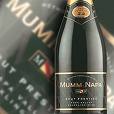 Champagne is the mother's milk of sparkling wine. It is very good — perhaps even profound — and very expensive, too. More than half of all Champagne sold in the United States is purchased between Thanksgiving and New Year's, because special occasions call for something, well, special. Champagne is the mother's milk of sparkling wine. It is very good — perhaps even profound — and very expensive, too. More than half of all Champagne sold in the United States is purchased between Thanksgiving and New Year's, because special occasions call for something, well, special.
The alternatives are, well, not so special. At least that's been the conventional wisdom lo these many years. Not so fast, though. While sparkling wines are produced in just about every winegrowing corner of the world, and few of them would be flattered by comparisons to Champagne, there are the exceptions.
California bubbly, for example. All snickering aside, California probably comes closest to Champagne when the issue is quality. When the issue is price, California wins in a landslide. As wine consumers continue to guard their wallets, the value aspect should make California sparkling wines the bubbly of choice this holiday season.
Read the whole thing over at Whitley On Wine.
Posted by Robert Whitley at 1:09 PM
|
|
 |
|